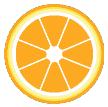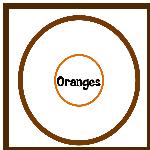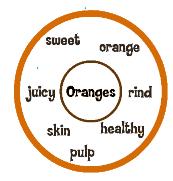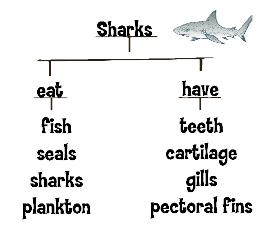 |
||||
 |
||||
A Circle Map is one of the first Thinking Maps you can easily introduce and use in Kindergarten. It is probably one of the simplest of the maps for young children to grasp and comprehend because they are taking a single idea and defining it in its context. Here is an example of how to use the Circle Map in a writing lesson. The Circle Map provides a way to gather information around a single topic—oranges.
Explain that today the children will be writing about oranges but first, we need to gather information. Pass out the orange slices. Have the children use their sense of sight to look at the slice, touch to feel it, smell, and finally taste. After finishing the tasting, show the whole fruit and turn to the board, drawing a a large square. Inside the square, draw a large circle. Inside the circle, draw another circle and in this smaller circle, write the word ORANGES.
After writing down all the various characteristics, go back over each one with the children, reading them aloud (point to each word and emphasize the beginning letter/sound combination as a way to reinforce children's vocabulary development). Have the children use the Circle Map to write a sentence about the orange in their journals. You can use a sentence starter (The orange was…). |
||||
A Tree Map is an outstanding visual for classifying ideas. It can be used along with the Circle Map in Kindergarten to help with writing sentences. The Tree Map provides the writer with the main idea, supporting idea, and the details. In a nutshell, it provides the why.
Prepare in advance: On a sheet of butcher paper, prepare an outline of a Tree Map. (I always tell my Kindergartners that if you take the Tree Map and flip it upside-down, it actually does look like a tree!)
Let's say you have been studying about sharks in your science lessons and want the children to write about what they've learned. The Tree Map is a perfect way to take information about sharks and classify that information. The topic is the trunk of the tree, the main ideas are the branches, and the supporting ideas or details are the leaves. The teacher begins by writing the topic and the main ideas (or the verbs) on the tree map. The children can provide the supporting ideas. From this tree map, it is easy to see how children can write sentences by simply following the map, beginning with the topic, then going along the 'branches' to the details!
If you are teaching children how to use transitional words (linking words) then, the tree map is perfect! A sentence might read: Sharks have pectoral fins and gills. It is easy to see how powerful the tree map is as a thinking map when used with Kindergartners!
*In my classroom, this was probably my favourite thinking map when we were writing sentences. |
||
 Prepare in advance
Prepare in advance
 Ask children to provide words that tell and define the orange that they just experienced. Write the words/phrases in the outer circle. Similar characteristics can be grouped or not; they can be written anywhere!
Ask children to provide words that tell and define the orange that they just experienced. Write the words/phrases in the outer circle. Similar characteristics can be grouped or not; they can be written anywhere!

 For example, one sentence might be: Sharks eat seals.
For example, one sentence might be: Sharks eat seals. 